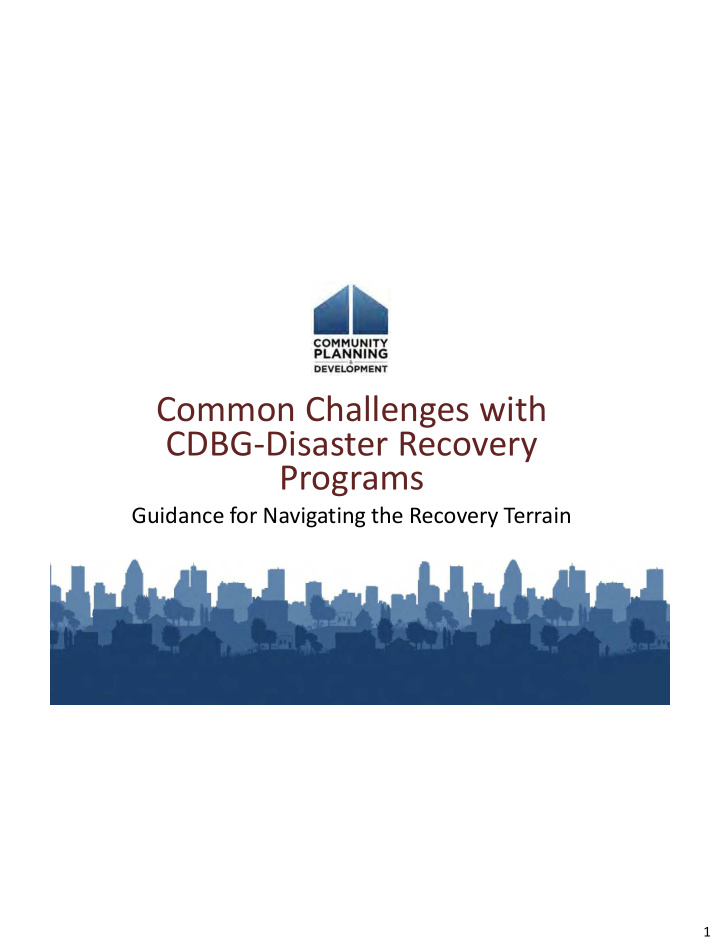



Common Challenges with CDBG-Disaster Recovery Programs Guidance for Navigating the Recovery Terrain 1
What are the Common Challenges? 2
Common Challenges Unique challenges arise in the administration of disaster recovery programs: • Preparedness and mitigation activities • Urgent need national objective • Leveraging CDBG-DR funds • CDBG-DR funds and subsequent disasters 3
Preparedness and Mitigation Activities 4
Preparedness and Mitigation Activities • Preparedness or mitigation activities: • activities that reduce hazard risk and lessen the impact a future disaster may have on people and property. • HUD encourages the incorporation of preparedness and mitigation measures into eligible rebuilding activities that address the impacts of the previous covered disaster. • However, preparedness and mitigation measures that are not part of a recovery/rebuilding activity are generally connected only to a future disaster – and are thus ineligible. 5
Preparedness and Mitigation Activities • Goal is to rebuild in ways that are safer and stronger. • Examples of eligible activities that often include mitigation measures include: Residential or commercial property buyouts; Floodplain mapping and land-use planning that guides rebuilding and recovery efforts When rebuilding damaged properties – elevating, floodproofing, outfitting with roof straps, storm shutters, using stronger materials, etc. When rebuilding damaged properties – installing tornado warning systems, basements, safe rooms, etc. 6
Urgent Need National Objective 7
Using the Urgent Need National Objective • Activities must alleviate conditions which pose a serious and immediate threat to community health/welfare (Reference 24 CFR 570.208(c) or 570.483(d) ) • Grantees must document how activities respond to disaster-related impact • Not necessary for an activity to begin within 18 months of the disaster 8
Leveraging CDBG-DR Funds 9
Leveraging CDBG-DR Funds US Army Corps of Engineers (USACE) • May use CDBG-DR funds for traditional USACE projects that are CDBG eligible (e.g., levees) • CDBG-DR cannot pay for projects (or portions of projects) for which USACE has been appropriated funds and/or is required to pay • CDBG-DR funds can be used as the non-federal match requirement connected with USACE funding 10
Leveraging CDBG-DR Funds US Army Corps of Engineers (USACE) • USACE often has lump-sum requirements for the non- Federal match • Grantee may disburse CDBG-DR funds when the funds are needed (Reference 24 CFR 85) • USACE must demonstrate a need for the funds and submit that information to the grantee 11
Leveraging CDBG-DR Funds Federal Emergency Management Agency (FEMA) • CDBG-DR funds can be used as the non-federal match for FEMA Public Assistance projects. • CDBG-DR funds can be used as the non-federal match for FEMA Public Assistance projects. Other • CDBG-DR may be used as non-federal cost-share, match, or contribution for other federally-funded projects. 12
CDBG-DR Funds and Subsequent Disasters 13
CDBG-DR Funds and Subsequent Disasters CDBG-DR from the original Presidentially-declared disaster may be used for a recovery activity where a recent disaster exacerbated damage or loss initially caused by the covered disaster for which funds were provided. Example: A recent disaster further damaged a public facility originally damaged in 2008, for which repairs have not been completed. Additional CDBG disaster recovery funds may be used to fully complete the repairs and address the need as it currently exists. 14
CDBG-DR Funds and Subsequent Disasters CDBG disaster recovery funds may not be used for activities that: 1. Address a need arising solely from a disaster for which funds were not appropriated, or 2. Address a need that has been met in full prior to the subsequent disaster Example: A home was damaged in 2005 and was fully rebuilt and re-occupied in 2007. The home was again damaged in 2008. CDBG-DR funds for the 2005 disaster cannot be used to address the 2008 damage 15
Recommend
More recommend